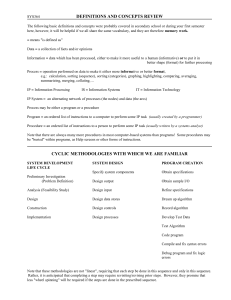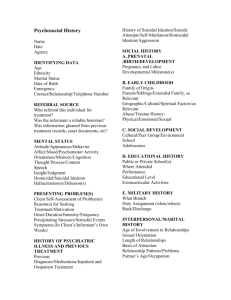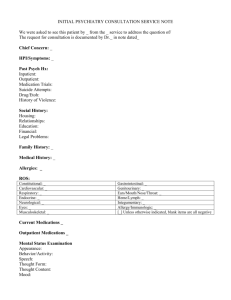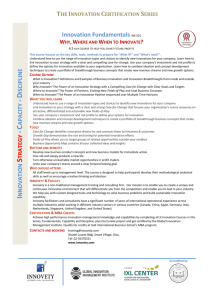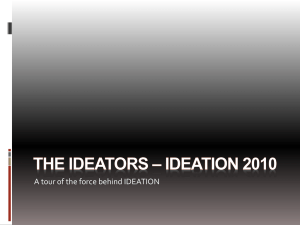Covidien
advertisement
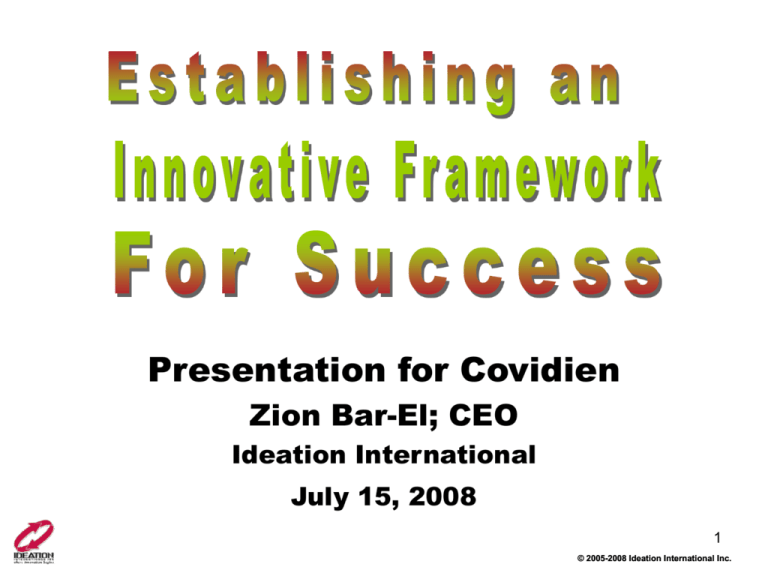
Presentation for Covidien Zion Bar-El; CEO Ideation International July 15, 2008 1 © 2005-2008 Ideation International Inc. Presentation Outline 1. Introduction 2. Who are we? 3. Where are we? 4. Creativity, innovation, inventions 5. TRIZ and I-TRIZ: applications, processes and tools 6. Covidien’s Journey. Implementation and execution 7. Q&A and closing remarks 2 © 2005-2008 Ideation International Inc. 1. Introduction 3 © 2005-2008 Ideation International Inc. Presentation Objectives Provide clear understanding on: Ideation Methodology, applications, process and tools Ideation differentiation and value proposition How to institutionalize the methodology within an organization and expected R.O.I. How Ideation can help Covidien grow organically to ensure technological and market leadership 4 © 2005-2008 Ideation International Inc. 2. Who Are We? 5 © 2005-2008 Ideation International Inc. Ideation Brief History Established in November 1992, Delaware corporation Provider of TRIZ-based services and products Acquired Kishinev School (Leading TRIZ School in Russia) Headquarters in Farmington Hills, MI The world largest group of TRIZ masters and certified TRIZ specialists Installed customer base of over 5000 enterprises worldwide Active in 40 countries and 60 universities Trained over 250,000 people worldwide Completed over 200 projects Conducts continuous research and advancement of the TRIZ methodology 6 © 2005-2008 Ideation International Inc. What is Ideation’s Business? Provider of I-TRIZ: Education Software Anticipatory Failure Determination Inventive Problem Solving Publications Books Papers Failure Analysis Analytical Services Age of Application 60 yrs 30 yrs Book Papers Failure Prediction 30 yrs Directed Evolution® Used internally Enhancement of Intellectual property Used internally Book Papers 20 yrs Papers 5 yrs 7 © 2005-2008 Ideation International Inc. Ideation’s Business Philosophy Customer Satisfaction Quality Innovation Excellence Respect Winning Customer Trust Caring Integrity Quality Commitment Building On Values 8 © 2005-2008 Ideation International Inc. Ideation’s Vision Enablers i Market Leader Technology Leader Leadership Assets Organizational Value Knowledge Based Human Resources Instruments 9 © 2005-2008 Ideation International Inc. Selected Successes-To-Date: Medical and Healthcare Industries Johnson & Johnson Advanced Cardiovascular Medtronic Merck Pfizer Eli Lily ADT New design, inventing around blocking patents, cost reduction, failure prediction, enhancing intellectual property, increasing market share, technology management, training Medical instrumentation Sanitary products Packaging of pills 10 © 2005-2008 Ideation International Inc. Selected Successes-To-Date: Universities, Hospitals and Healthcare Agencies Colombia University Creighton University University of Pennsylvania University of Nebraska University of Western Ontario Aurora Hospitals Public healthcare Iowa Health system New design, enhancing intellectual property, increasing market share, licensing technologies, start-ups Endoscopic surgical tool Machine-Brain interface Assisted delivery forceps Medical devices Pandemic flu Obesity Hospital logistics Artificial retina 11 © 2005-2008 Ideation International Inc. 3. Where Are We? 12 © 2005-2008 Ideation International Inc. A Characteristic of Today’s Business World Ever-increasing diversification of products in the market today due to: – Rapidly accelerating technological innovation – Shortened product life-cycles – Diversification of customer needs New technology spawns new markets 13 © 2005-2008 Ideation International Inc. Trends in the Global Marketplace 1950s and 60s 1970s and 80s American industries dominated markets American industries originated most of the world’s technologies Consumers preferred “Made in USA” labels; USA meant quality Worldwide global competition Other nations capture markets Innovation is no guarantee of product success Ineffective U.S. response to market trends Success requires understanding customer needs and expectations Success requires meeting market needs promptly Success requires providing value to all customers Success requires innovative products Success can be attained through Systematic Innovation using the I-TRIZ Methodology 1990s and 00s 14 © 2005-2008 Ideation International Inc. Business Challenges I-TRIZ provides value by supporting a variety of business needs Expanding Breadth of Business Opportunities Matching of Technological Solutions to Market Needs – Managing Technology, Society, and Market Increasing Probability of Success – Rapidly Overcoming Technological Problems Shrinking Time to Market – Development and Implementation of Products and Processes Reducing Cycle Time While Maximizing Quality & Reliability – Integration of Innovation and Six Sigma Maximizing Return on Capital Investment – Cost of Development, Capital Equipment, Facilities – Life Expectancy of Capital Investment Controlling growth and profitability 15 © 2005-2008 Ideation International Inc. Trends of R&D Evolution Generation 1 Generation 2 Generation 3 Generation 4 Tools for: Research Information Creativity Primitive Sophisticated Complex Paper Paper Computer Trial & Error of a talented person Trial & Error of a large team (Brainstorming) Integrated on the base of Hi-Tech, networking and TRIZ Organization: Structure Linear Hierarchical Matrix Network Principle Non bureaucratic Bureaucratic Bureaucratic Non bureaucratic N/A Occasional Reactive General Personal relations Discipline Discipline+ Initiative Entrepreneurial R&D Nothing special Engineering Scientific Creative Market Pro-active Culture: 16 © 2005-2008 Ideation International Inc. Evolutionary Positioning: S-Curve Analysis Stage 0 - a system does not yet exist but important conditions for its emergence are developing Stage 1 - a new system appears due to a highlevel invention and begins developing slowly 3 4 5 Stage 3 - begins when the resources on which the original system is based are mostly exhausted 2 0 Stage 2 - begins when society recognizes the value of the new system Stage 4 - begins when a new system (or the next generation of the current system) emerges to replace the existing one 1 Time Stage 5 - begins if the new system does not completely replace the existing system, which still has limited application 17 © 2005-2008 Ideation International Inc. 17 Managing the Strategic Challenge of Change Levels of Change Leading Anticipating Reacting Events • Create new technologies and products • Launch new markets • Raise industry standards • Redefine customer expectations • Increase pace of industry product cycles • Globalization of markets • Creation of new customer segments • Emergence of conflicting technologies • Competitor’s product moves • New government policies • Unexpected customer demands Strategy • Force other firms to follow • Line up resources (e.g. venture partners, cross-cultural employees, currency trading skills) early • Develop corresponding marketing channels • Create technical options • Release better products • Create services that exploit change • Repackage existing products 18 © 2005-2008 Ideation International Inc. 4. Creativity, innovation, inventions 19 © 2005-2008 Ideation International Inc. History of Creativity Creative activity of humans starts with the human history: ~1500 BC – myths about Dedalus – the first human-inventor Beginning of AD – descriptions of group search for solutions applied by Scythian and German tribes – Brainstorming predecessors. 4th century of AD – attempts to create a science of invention (heuristics) by Papp from Alexandria. 13th century – Great Art by R. Lullius (St. Lullius) published in 1480 – a technique for systematic exploration of possibilities – predecessor of morphological charts. 19th century – evolutionary theories by Lamarck and Darwin (biology), Comte and Marks (sociology). Attempts of techno- and socio-Darwinism by Spencer. End of 19th – beginning of the 20th century - beginning of psychological research in creativity. Creative Imagination by T. Ribot, works of Freud, etc. Middle of the 20th century - System approach by Bertalanffy, Brainstorming by A. Osborn; control questions for inventors by Osborn, Thring, Laithwait, etc. 20 © 2005-2008 Ideation International Inc. Components of Creative Thinking Adults' Thinking Children's Thinking "TRIZ" Thinking Fear of contradictions, aspiration to avoid them Non sensitiveness to contradictions, absence of aspiration to avoid them in their arguments Love for contradictions, search for contradictions in problems. Understanding that revealing and formulation of an obvious contradiction is a step toward to its resolution Metaphysical approach, consideration the objects, processes and phenomena separately, non systematically Syncretism, aspiration to connect "everything with everything" Systematic approach, aspiration to reveal the connections between remote objects, processes and phenomena, that often look as though they are not connected at all Unorganized combination of various types of deductions, that are often applied erroneously Traduction - type of deduction, erroneous from the classical logic viewpoint, were the deductions are made from the one specific fact to another specific one Deductions by analogue, transition of deductions, ideas, solutions between various systems, with various levels of generality (an organized combination of induction, deduction, and traduction) Combination of logic thinking and natural intuition Natural, inborn ability to produce an intuitive deduction Combination of logic thinking with purposely formed intuition "Laws obedience" - use of intuitively known or verbalized laws "Creation of laws " -spontaneous search and development of intuitive and verbalized laws Purposeful search and development of laws; verbalization of the intuitive laws Attempts to brain storm the difficult problem from one shot, retreat and giving the solving up in the case of failure Substitution of the problem. If a child is not able to solve a problem, he will purposely modify the conditions and the rules and than will solve the problem, that is possible for him to solve Substitution of the problem by another one, that can be solved by certain rules. 21 © 2005-2008 Ideation International Inc. Innovation Techniques besides TRIZ 1950s 1970s Brainstorming by A. Osborn Innovative design by J. Jones Morphological analysis by F. Zwicky Evolution of technology by D. Sahal Value Engineering Analysis by L. Miles Quality Function Deployment (QFD) Taghuchi methods Psychological activation by DeBono Fishbone diagram by Ishikawa, etc. Third Wave by A. Toffler 1960s Synectics by Gordon – professional Brainstorming with the utilization of analogies Revealing and resolving contradictions by J. Page Control of though in creative work by E. Matchett 1980s Six Sigma HAZOP and FMEA DFMA 1990s Innovative design by J. Jones Concurrent engineering Systemic design – PERT and PATTERN TOC by Goldratt Technological forecasting Reengineering by M. Hammer DFSS 22 © 2005-2008 Ideation International Inc. What is TRIZ? Russian acronym for the Theory of Inventive Problem Solving Systematic, structured way of thinking supported by numerous tools Science based on patterns of invention and evolution 23 © 2005-2008 Ideation International Inc. Over 60 Years of Development initiated and led by G. Altshuller and involving hundreds of scientists and inventors Practical experience of thousands of scientists, inventors, engineers, managers, businessmen, etc. More than 3.000.000 world- wide patents History of evolution in different areas of technology and science, social systems, business, management, art, languages, etc. Feedback from solving with TRIZ thousands of problems 24 © 2005-2008 Ideation International Inc. 24 What is I-TRIZ? The next step in TRIZ evolution developed in the USA by Ideation International Inc. Advanced, westernized and software supported version of TRIZ Version of TRIZ in which Problem Solving includes: – – – – – Revealing the problem Formulating the problem Developing the solution Evaluating the solution Implementing the solution 25 © 2005-2008 Ideation International Inc. Ideation TRIZ Development Ideation TRIZ Combination of all effective approaches to creative problem solving and control of technological evolution Hybridization of different approaches to creativity 26 © 2005-2008 Ideation International Inc. Ideation TRIZ: Collaboration with Other Methods FMA, HAZOP Theory of Constraints Ideation TRIZ Technological Forecasting DFMA And more… 27 © 2005-2008 Ideation International Inc. Ideation Operating System for Innovation A systematic procedure for identifying the root causes of a failure or other undesired phenomenon in a system, and for making corrections in a timely manner. Failure Prediction A systematic procedure for identifying beforehand, and then preventing, all dangerous or harmful events that might be associated with a system. DE AFD® IPS CIP Control of Intellectual Property A systematic procedure for increasing IP value and providing protection from infringement and circumvention. Inventive Problem Solving Failure Analysis Anticipatory Failure Determination Directed Evolution® A systematic procedure for strategically evolving future generations of technological systems A systematic procedure for resolving tough technological problems, enhancing system parameters, improving quality, reducing cost, etc. for current generations of products and technologies. 28 © 2005-2008 Ideation International Inc. 5. TRIZ and I-TRIZ: Applications, processes and tools 29 © 2005-2008 Ideation International Inc. 6. Covidien Journey. Implementation & Execution 30 © 2005-2008 Ideation International Inc. Based on Future Thinking Leadership Teams Vision What we want to be Values Mission Objectives Strategies Goals Initiatives Milestones What we believe in What we are going to do What we are going to win How we are going to win How we want to be measured Tasks to convert strategies into reality Measurement of progress 31 © 2005-2008 Ideation International Inc. Based on Market Knowledge and Market Vision of the Future Intelligence analysis Prioritize market segmentation Segment, profiles & trends (market lifecycles) – Value sets, buyer criteria, price elasticity – Trends – emerging and declining value attributes Competitive analysis and trends Market share tracking Market forecasting Customer readiness assessments Strategic planning Intellectual property planning and licensing – technology, patent fences Readiness assessments: organizational competencies 32 © 2005-2008 Ideation International Inc. Put Emphasis on... Skills / Resources Strategy Product Compensation Market IP Technology IP Prioritize & Selection Company Mission Knowledge If new “S” curve – reuse, rebuild, replace “the house” Build Bottom-up – IP Building Blocks & Architecture 33 © 2005-2008 Ideation International Inc. The Ideal: Where You Want to Be Opportunity B Enhanced probability of success of options D A C E F Managemen t Selected Ideal Future Position G H J Controllable creative process Leverage Point I (if we could be here we would have a significant competitive advantage) 34 © 2005-2008 Ideation International Inc. Mapping the Future Using DE Potential longterm problems need to be understood and taken into account. Time 35 © 2005-2008 Ideation International Inc. Integrated Tools Phase 0 Phase I Concept Planning & Spec. Phase II Development Phase III Test/Prototype Phase IV Scale-up Robust Design QFD TRIZ FMEA DF(X) Phase 0 Review Phase I Review Phase II Review Phase III Review Phase IV Review 36 © 2005-2008 Ideation International Inc. Structured Innovation Idea Generation & Enrichment Idea Selection Opportunity Analysis Gate 2 ENGINE To NPP Gate 3 Assess Gate 6 Develop Com Concept Definition Opportunity Identification Gate 1 Gate n New Concept Development Technology Stage Gate (TSG) 37 © 2005-2008 Ideation International Inc. 37 Structured Innovation Output Number & GP Value of Business Concepts Delivered to Gate 3 Build G1 Assess 1 G2 2 Develop G3 3 4 5 $ Commercialize G6 6 •Technology “fusion” from internal/ external search coupled with Rapid Screening •Cycle Time Compression -- frees resources 38 © 2005-2008 Ideation International Inc. 38 Integration within Business Business Core Competencies, Investments & Assets Financial Perspective Sales Growth Controlled Growth Earnings Growth Market Change Competitive Intelligence Knowledge Application Industry Change Business Dynamics Social Change Regulatory Awareness Technological Change Technology Awareness Organizational Change Directing the Evolution of Technological Systems Supplemental I-TRIZ Based Research of Historic and Inherited Ideas Business Intelligence Business Environment 39 © 2005-2008 Ideation International Inc. Importance of Controlling the Innovation Cycle Cash flow Innovation cycle time Tb To Tf Net Profit Period Tr Ts TP To Opportunity occurs TP Opportunity is perceived Tb Project activity begins Tf Product definition and plans freeze Tr Ts BET Te BET Te Product is released to production First customers are satisfied Break-even time Project becomes extinct From Accelerated Innovation by Marvin Patterson 40 © 2005-2008 Ideation International Inc. Management of Technology 41 © 2005-2008 Ideation International Inc. Covidien’s Journey IPS workshop with the project – July 28 AFD Failure Prediction with a project – August AFD Failure Analysis with a project – September LCD technological problem – July What to Expect? 42 © 2005-2008 Ideation International Inc. 7. Q&A and Closing Remarks 43 © 2005-2008 Ideation International Inc. Lee I. Fenicle, Director Intellectual Resources Management Creighton University “Using Invention on Demand and Directed Evolution, Ideation’s I-TRIZ staff helped us turn one patented surgical device into a core of products that we used to start a company. Our company has received its second round of venture-backed funding and will be selling its first products in the next few months. Without Ideation’s help we would have licensed our technology and would be waiting for a royalty stream for a very long time. For medical devices, I-TRIZ has proven to be the best way to attack a future market, solve design problems and to get the most out of the intellectual property we have.” 44 © 2005-2008 Ideation International Inc.
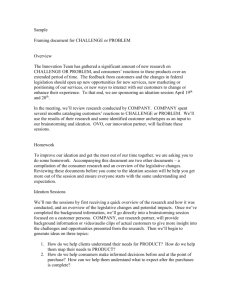
![[#BPIDEA-13] Give the option to show `View` count by unique views](http://s3.studylib.net/store/data/007700494_2-3911615de654a0135ad82f55710606d1-300x300.png)
